Strategic Management Formative Report: An Analysis of H&M's Business
VerifiedAdded on 2023/01/05
|8
|1720
|70
Report
AI Summary
This report provides a strategic management analysis of H&M, a leading clothing retail chain, using frameworks like PESTLE, Porter's Five Forces, SWOT, and VRIO to assess its internal and external environments. The analysis covers political, economic, social, technological, legal, and environmental factors impacting H&M's operations in the UK, along with the competitive forces shaping the retail industry. The VRIO analysis evaluates H&M's resources and capabilities, highlighting its strengths in brand reputation, innovation, and organizational capabilities. The SWOT analysis identifies key strengths, weaknesses, opportunities, and threats, leading to recommendations for H&M to enhance its market position through market surveys, manufacturing setup, product diversification and strategic alliances. The report concludes that H&M has effectively balanced its strengths and weaknesses, maintaining brand value and delivering high-quality goods, but should address issues like product imitation and developing its own distribution chain.
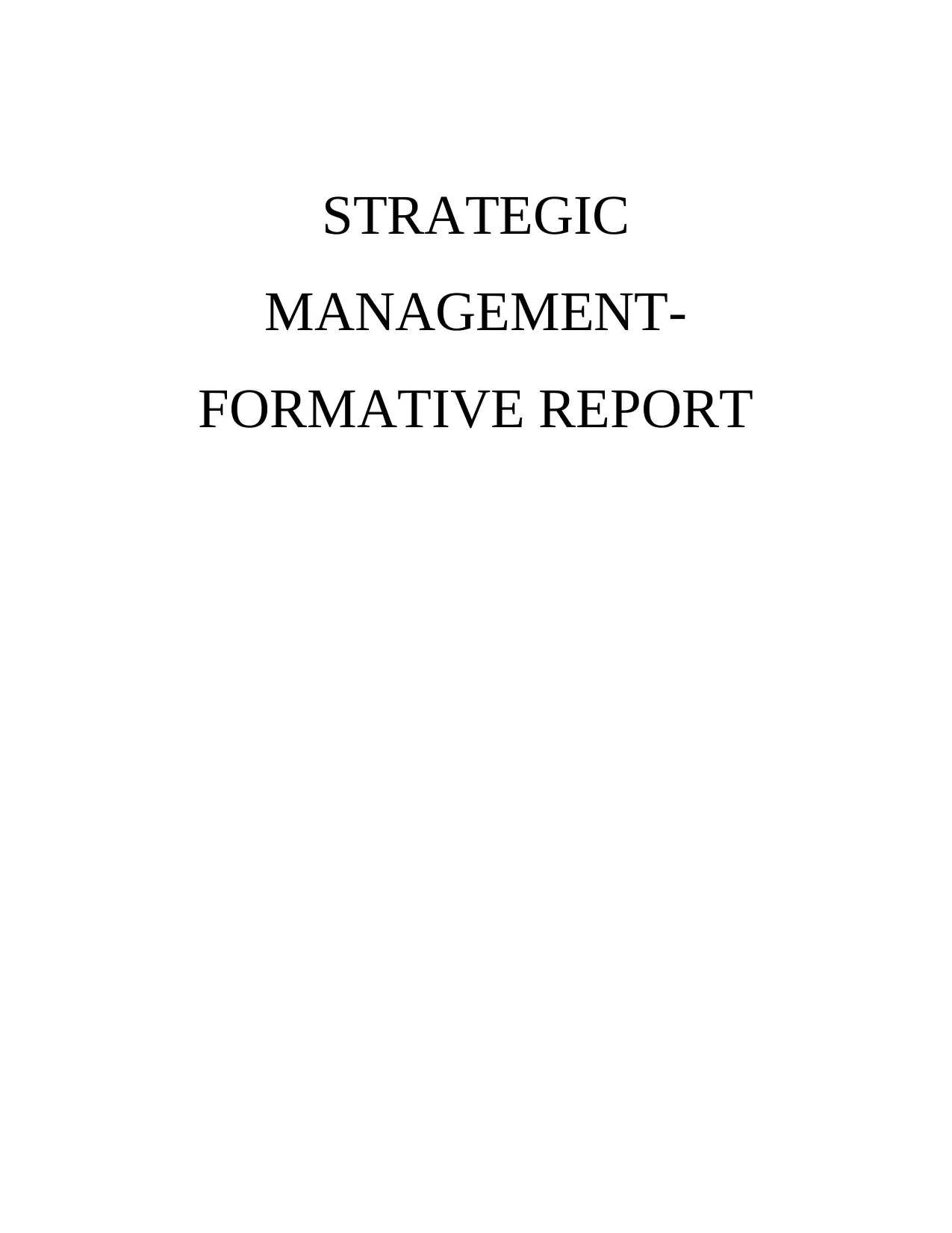
STRATEGIC
MANAGEMENT-
FORMATIVE REPORT
MANAGEMENT-
FORMATIVE REPORT
Paraphrase This Document
Need a fresh take? Get an instant paraphrase of this document with our AI Paraphraser
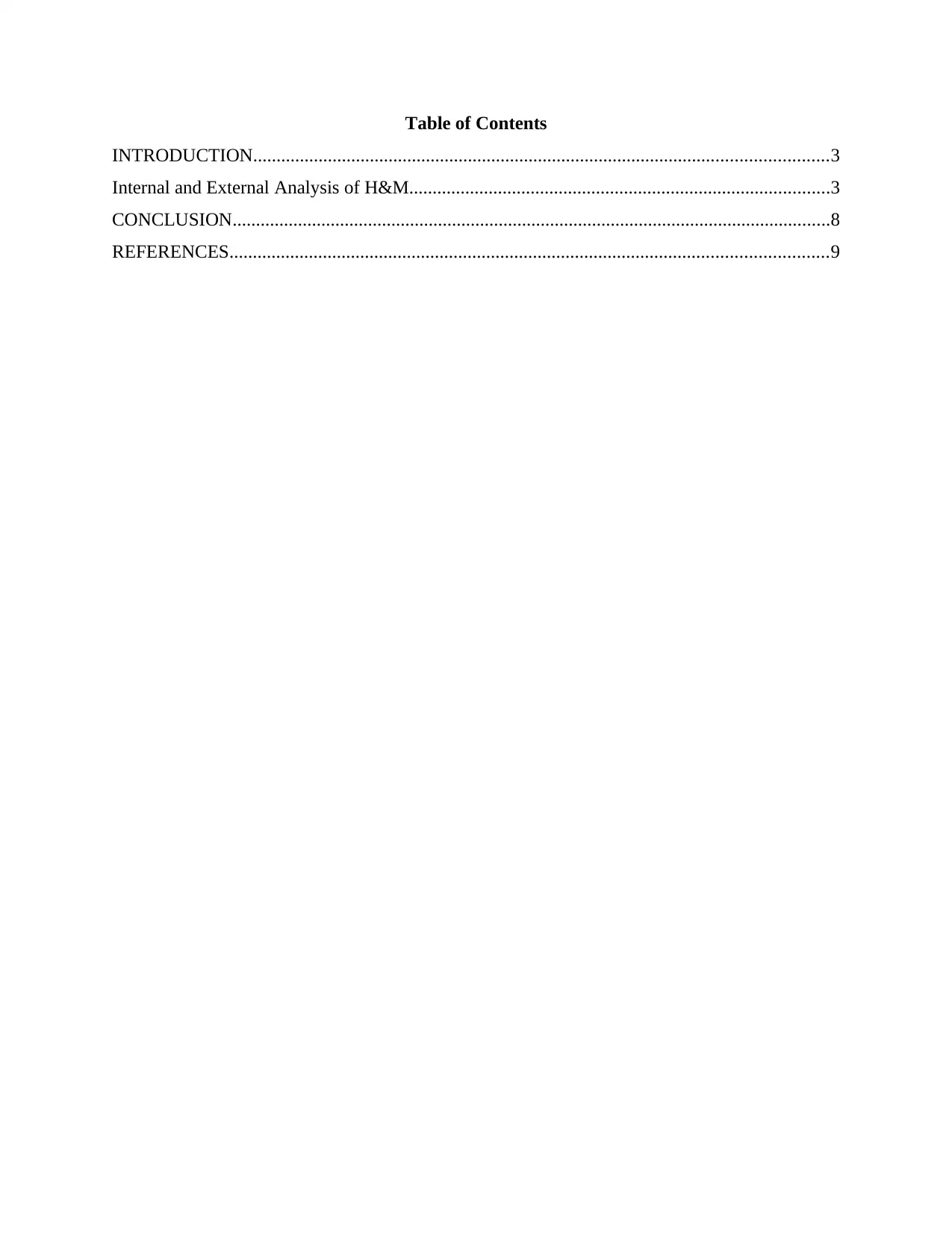
Table of Contents
INTRODUCTION...........................................................................................................................3
Internal and External Analysis of H&M..........................................................................................3
CONCLUSION................................................................................................................................8
REFERENCES................................................................................................................................9
INTRODUCTION...........................................................................................................................3
Internal and External Analysis of H&M..........................................................................................3
CONCLUSION................................................................................................................................8
REFERENCES................................................................................................................................9
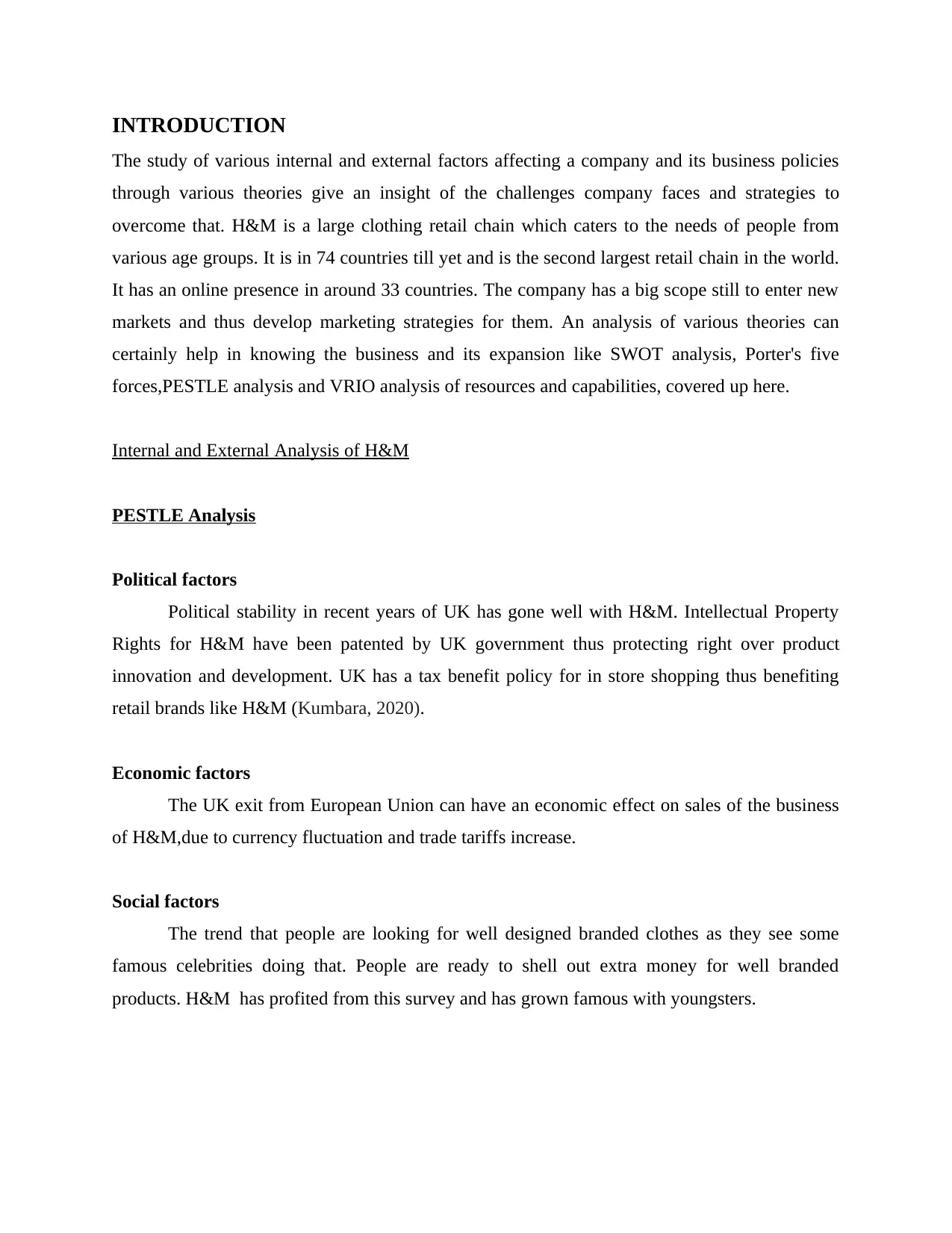
INTRODUCTION
The study of various internal and external factors affecting a company and its business policies
through various theories give an insight of the challenges company faces and strategies to
overcome that. H&M is a large clothing retail chain which caters to the needs of people from
various age groups. It is in 74 countries till yet and is the second largest retail chain in the world.
It has an online presence in around 33 countries. The company has a big scope still to enter new
markets and thus develop marketing strategies for them. An analysis of various theories can
certainly help in knowing the business and its expansion like SWOT analysis, Porter's five
forces,PESTLE analysis and VRIO analysis of resources and capabilities, covered up here.
Internal and External Analysis of H&M
PESTLE Analysis
Political factors
Political stability in recent years of UK has gone well with H&M. Intellectual Property
Rights for H&M have been patented by UK government thus protecting right over product
innovation and development. UK has a tax benefit policy for in store shopping thus benefiting
retail brands like H&M (Kumbara, 2020).
Economic factors
The UK exit from European Union can have an economic effect on sales of the business
of H&M,due to currency fluctuation and trade tariffs increase.
Social factors
The trend that people are looking for well designed branded clothes as they see some
famous celebrities doing that. People are ready to shell out extra money for well branded
products. H&M has profited from this survey and has grown famous with youngsters.
The study of various internal and external factors affecting a company and its business policies
through various theories give an insight of the challenges company faces and strategies to
overcome that. H&M is a large clothing retail chain which caters to the needs of people from
various age groups. It is in 74 countries till yet and is the second largest retail chain in the world.
It has an online presence in around 33 countries. The company has a big scope still to enter new
markets and thus develop marketing strategies for them. An analysis of various theories can
certainly help in knowing the business and its expansion like SWOT analysis, Porter's five
forces,PESTLE analysis and VRIO analysis of resources and capabilities, covered up here.
Internal and External Analysis of H&M
PESTLE Analysis
Political factors
Political stability in recent years of UK has gone well with H&M. Intellectual Property
Rights for H&M have been patented by UK government thus protecting right over product
innovation and development. UK has a tax benefit policy for in store shopping thus benefiting
retail brands like H&M (Kumbara, 2020).
Economic factors
The UK exit from European Union can have an economic effect on sales of the business
of H&M,due to currency fluctuation and trade tariffs increase.
Social factors
The trend that people are looking for well designed branded clothes as they see some
famous celebrities doing that. People are ready to shell out extra money for well branded
products. H&M has profited from this survey and has grown famous with youngsters.
⊘ This is a preview!⊘
Do you want full access?
Subscribe today to unlock all pages.

Trusted by 1+ million students worldwide

Technological factors
With the advent of e-commerce in past few years, there has been a certain segment which
now like to order online and purchase products, H & M is on an emerging phase in it. It has yet
to go a long way in it to compete with other brands (Kasemkiatthai, 2020).
Legal factors
H&M although having Intellectual Property Rights has to face counterfeits in market
and has to shell out a part of its revenue dealing with cases of trademarks and product features
related issues.
Environmental factors
Textile industry is the second most hazardous industry after oil and petroleum. The water
and air pollution caused is to be regulated, wastes of textiles have to be treated before they are let
out in water. H&M spends a considerable amount in treating wastes to avoid pollution fine and
quotas. H&M is also using recycled clothes for production (Kumbara, 2020).
Porter's five forces
Threat of new entrants
New players for H&M are watched out for their product quality, differentiation and
market segmentation. The threat posed stands in low range due to H&M being old in business
with a dedicated customer base already. H&M focuses on product innovation and giving
seasonal discounts to keep its customers attracted. For H&M it is easy to minimize costs by mass
production but it is not easy for a new entrant to do so. H&M have a product development team
which is doing innovation and thus reduce threat of new entrant declining their market share.
Bargaining power of suppliers
H&M has a large number of suppliers to choose from. Thus, getting to switch between
them for a low cost option is easy. Thus suppliers do not get an upper hand here and H&M saves
With the advent of e-commerce in past few years, there has been a certain segment which
now like to order online and purchase products, H & M is on an emerging phase in it. It has yet
to go a long way in it to compete with other brands (Kasemkiatthai, 2020).
Legal factors
H&M although having Intellectual Property Rights has to face counterfeits in market
and has to shell out a part of its revenue dealing with cases of trademarks and product features
related issues.
Environmental factors
Textile industry is the second most hazardous industry after oil and petroleum. The water
and air pollution caused is to be regulated, wastes of textiles have to be treated before they are let
out in water. H&M spends a considerable amount in treating wastes to avoid pollution fine and
quotas. H&M is also using recycled clothes for production (Kumbara, 2020).
Porter's five forces
Threat of new entrants
New players for H&M are watched out for their product quality, differentiation and
market segmentation. The threat posed stands in low range due to H&M being old in business
with a dedicated customer base already. H&M focuses on product innovation and giving
seasonal discounts to keep its customers attracted. For H&M it is easy to minimize costs by mass
production but it is not easy for a new entrant to do so. H&M have a product development team
which is doing innovation and thus reduce threat of new entrant declining their market share.
Bargaining power of suppliers
H&M has a large number of suppliers to choose from. Thus, getting to switch between
them for a low cost option is easy. Thus suppliers do not get an upper hand here and H&M saves
Paraphrase This Document
Need a fresh take? Get an instant paraphrase of this document with our AI Paraphraser

money here. As the retail industry is an important client for suppliers, supplier thus put
reasonable pricing for H & M thus reducing the bargaining power (Mierzejewska, 2017).
Bargaining power of Buyers
In the retail industry producers are less in numbers than customers. This makes the
bargaining power of buyers low. H&M has a large customer base among various age groups and
their product alternative is very less in market thus H&M remains unaffected by their bargaining
power. H&M influence buyers more by low pricing with high quality products and thus
generates profits.
Threat of substitutes
Substitutes or alternatives can cause a decline in market share and customer base. Threat
of substitutes stands low to medium for H&M. H&M has a pricing of low cost and high quality
product which is not affordable with every competitor. Product differentiation and providing
greater quality products is the key for H&M here to combat substitutes and increase market
share.
Rivalry among Existing Firms
There is high competition among retail brands in UK to gain an edge of market share
over other brands. H&M goes for product differentiation and diversifying its product range to
gain a new set of customers by offering quality. Also by high profile marketing campaigns and
seasonal discounts, it is able to survive competition (Perera,2017).
Resources and Capabilities(VRIO)
The VRIO analysis of H&M takes consideration of four factors namely:
Resource/
Capability
Product
innovation
Human Resources Brand Reputation Organizational
functions
Value Yes Yes Yes Yes
Rarity Yes No Yes Yes
reasonable pricing for H & M thus reducing the bargaining power (Mierzejewska, 2017).
Bargaining power of Buyers
In the retail industry producers are less in numbers than customers. This makes the
bargaining power of buyers low. H&M has a large customer base among various age groups and
their product alternative is very less in market thus H&M remains unaffected by their bargaining
power. H&M influence buyers more by low pricing with high quality products and thus
generates profits.
Threat of substitutes
Substitutes or alternatives can cause a decline in market share and customer base. Threat
of substitutes stands low to medium for H&M. H&M has a pricing of low cost and high quality
product which is not affordable with every competitor. Product differentiation and providing
greater quality products is the key for H&M here to combat substitutes and increase market
share.
Rivalry among Existing Firms
There is high competition among retail brands in UK to gain an edge of market share
over other brands. H&M goes for product differentiation and diversifying its product range to
gain a new set of customers by offering quality. Also by high profile marketing campaigns and
seasonal discounts, it is able to survive competition (Perera,2017).
Resources and Capabilities(VRIO)
The VRIO analysis of H&M takes consideration of four factors namely:
Resource/
Capability
Product
innovation
Human Resources Brand Reputation Organizational
functions
Value Yes Yes Yes Yes
Rarity Yes No Yes Yes
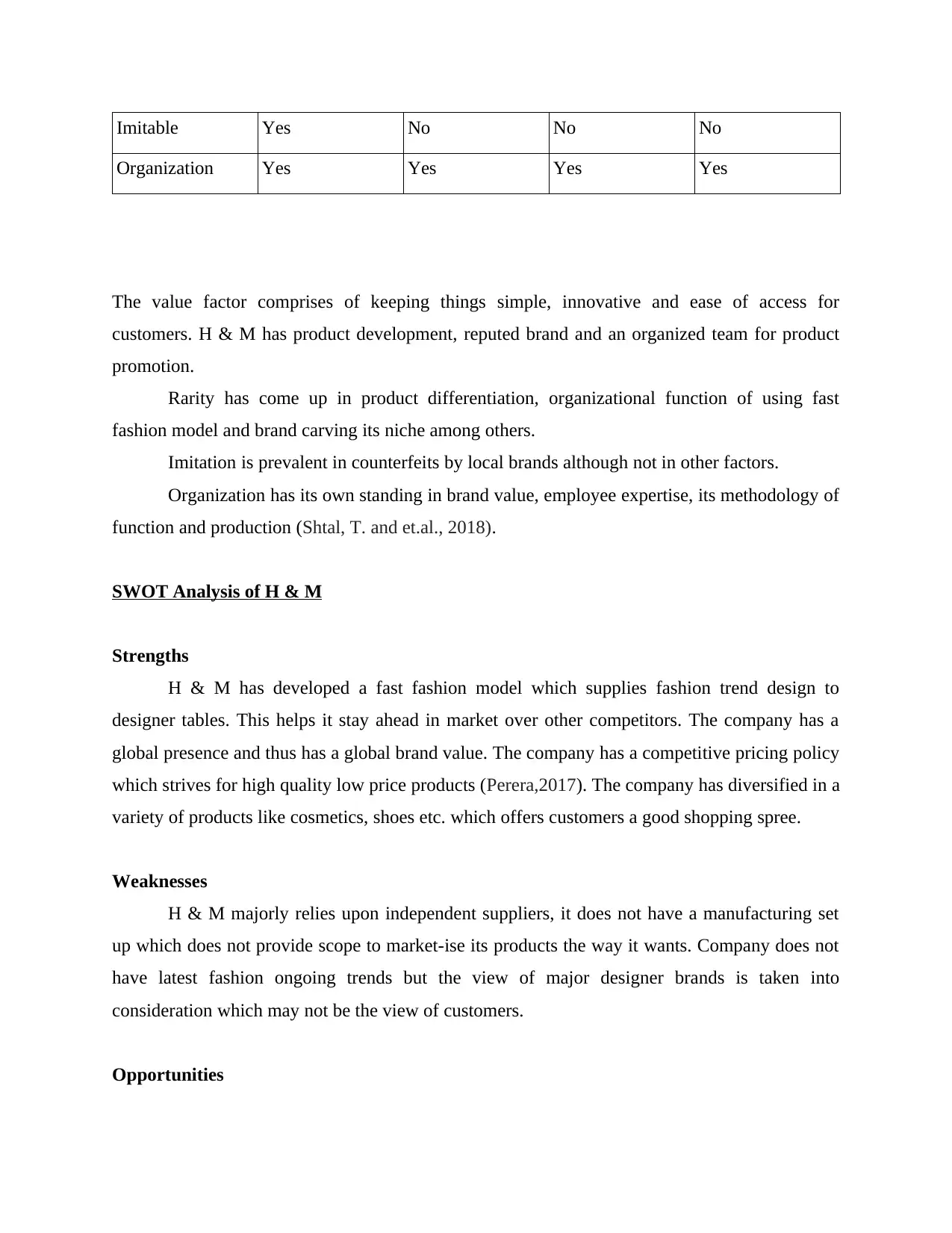
Imitable Yes No No No
Organization Yes Yes Yes Yes
The value factor comprises of keeping things simple, innovative and ease of access for
customers. H & M has product development, reputed brand and an organized team for product
promotion.
Rarity has come up in product differentiation, organizational function of using fast
fashion model and brand carving its niche among others.
Imitation is prevalent in counterfeits by local brands although not in other factors.
Organization has its own standing in brand value, employee expertise, its methodology of
function and production (Shtal, T. and et.al., 2018).
SWOT Analysis of H & M
Strengths
H & M has developed a fast fashion model which supplies fashion trend design to
designer tables. This helps it stay ahead in market over other competitors. The company has a
global presence and thus has a global brand value. The company has a competitive pricing policy
which strives for high quality low price products (Perera,2017). The company has diversified in a
variety of products like cosmetics, shoes etc. which offers customers a good shopping spree.
Weaknesses
H & M majorly relies upon independent suppliers, it does not have a manufacturing set
up which does not provide scope to market-ise its products the way it wants. Company does not
have latest fashion ongoing trends but the view of major designer brands is taken into
consideration which may not be the view of customers.
Opportunities
Organization Yes Yes Yes Yes
The value factor comprises of keeping things simple, innovative and ease of access for
customers. H & M has product development, reputed brand and an organized team for product
promotion.
Rarity has come up in product differentiation, organizational function of using fast
fashion model and brand carving its niche among others.
Imitation is prevalent in counterfeits by local brands although not in other factors.
Organization has its own standing in brand value, employee expertise, its methodology of
function and production (Shtal, T. and et.al., 2018).
SWOT Analysis of H & M
Strengths
H & M has developed a fast fashion model which supplies fashion trend design to
designer tables. This helps it stay ahead in market over other competitors. The company has a
global presence and thus has a global brand value. The company has a competitive pricing policy
which strives for high quality low price products (Perera,2017). The company has diversified in a
variety of products like cosmetics, shoes etc. which offers customers a good shopping spree.
Weaknesses
H & M majorly relies upon independent suppliers, it does not have a manufacturing set
up which does not provide scope to market-ise its products the way it wants. Company does not
have latest fashion ongoing trends but the view of major designer brands is taken into
consideration which may not be the view of customers.
Opportunities
⊘ This is a preview!⊘
Do you want full access?
Subscribe today to unlock all pages.

Trusted by 1+ million students worldwide
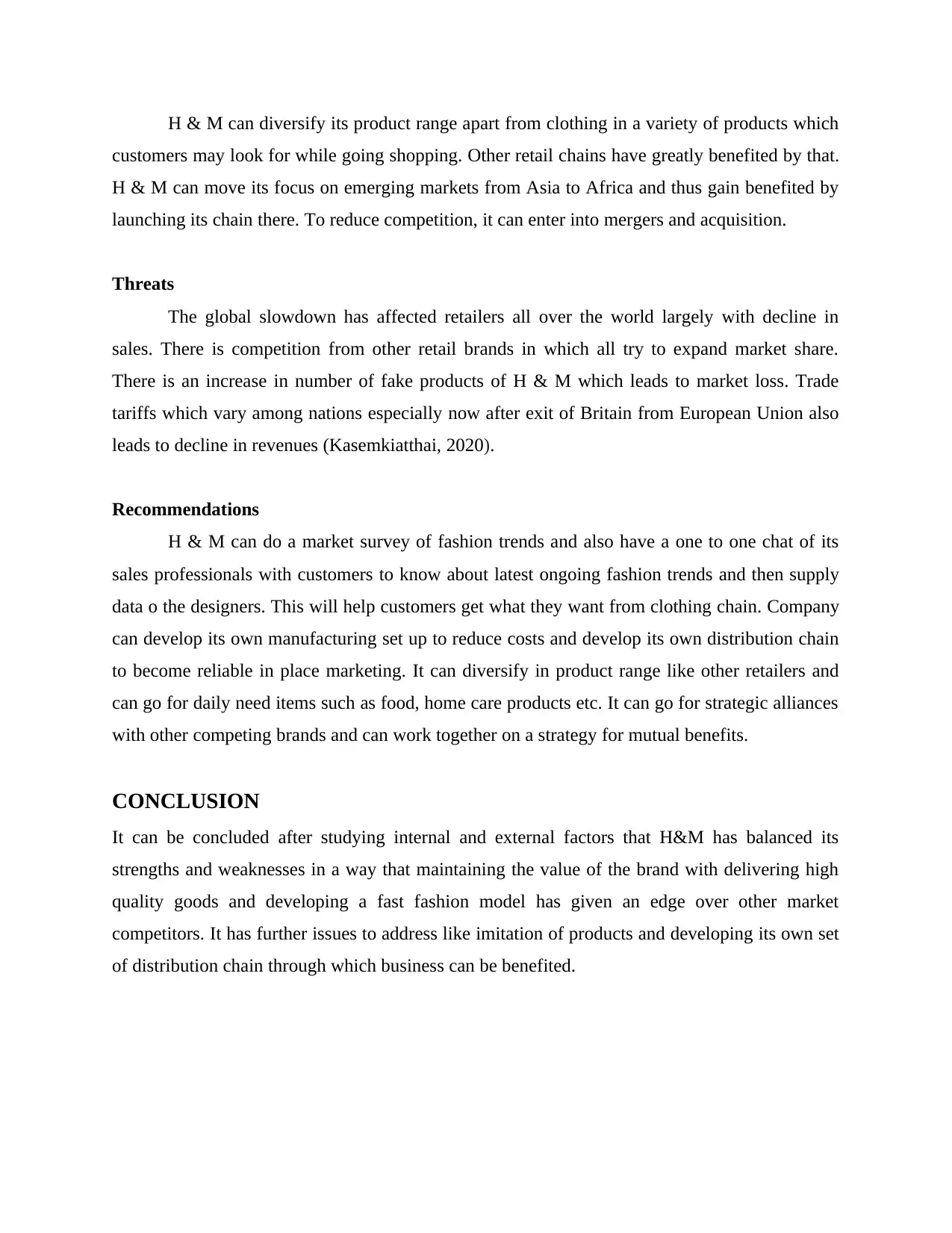
H & M can diversify its product range apart from clothing in a variety of products which
customers may look for while going shopping. Other retail chains have greatly benefited by that.
H & M can move its focus on emerging markets from Asia to Africa and thus gain benefited by
launching its chain there. To reduce competition, it can enter into mergers and acquisition.
Threats
The global slowdown has affected retailers all over the world largely with decline in
sales. There is competition from other retail brands in which all try to expand market share.
There is an increase in number of fake products of H & M which leads to market loss. Trade
tariffs which vary among nations especially now after exit of Britain from European Union also
leads to decline in revenues (Kasemkiatthai, 2020).
Recommendations
H & M can do a market survey of fashion trends and also have a one to one chat of its
sales professionals with customers to know about latest ongoing fashion trends and then supply
data o the designers. This will help customers get what they want from clothing chain. Company
can develop its own manufacturing set up to reduce costs and develop its own distribution chain
to become reliable in place marketing. It can diversify in product range like other retailers and
can go for daily need items such as food, home care products etc. It can go for strategic alliances
with other competing brands and can work together on a strategy for mutual benefits.
CONCLUSION
It can be concluded after studying internal and external factors that H&M has balanced its
strengths and weaknesses in a way that maintaining the value of the brand with delivering high
quality goods and developing a fast fashion model has given an edge over other market
competitors. It has further issues to address like imitation of products and developing its own set
of distribution chain through which business can be benefited.
customers may look for while going shopping. Other retail chains have greatly benefited by that.
H & M can move its focus on emerging markets from Asia to Africa and thus gain benefited by
launching its chain there. To reduce competition, it can enter into mergers and acquisition.
Threats
The global slowdown has affected retailers all over the world largely with decline in
sales. There is competition from other retail brands in which all try to expand market share.
There is an increase in number of fake products of H & M which leads to market loss. Trade
tariffs which vary among nations especially now after exit of Britain from European Union also
leads to decline in revenues (Kasemkiatthai, 2020).
Recommendations
H & M can do a market survey of fashion trends and also have a one to one chat of its
sales professionals with customers to know about latest ongoing fashion trends and then supply
data o the designers. This will help customers get what they want from clothing chain. Company
can develop its own manufacturing set up to reduce costs and develop its own distribution chain
to become reliable in place marketing. It can diversify in product range like other retailers and
can go for daily need items such as food, home care products etc. It can go for strategic alliances
with other competing brands and can work together on a strategy for mutual benefits.
CONCLUSION
It can be concluded after studying internal and external factors that H&M has balanced its
strengths and weaknesses in a way that maintaining the value of the brand with delivering high
quality goods and developing a fast fashion model has given an edge over other market
competitors. It has further issues to address like imitation of products and developing its own set
of distribution chain through which business can be benefited.
Paraphrase This Document
Need a fresh take? Get an instant paraphrase of this document with our AI Paraphraser

REFERENCES
Books and journals
Kasemkiatthai, N. 2020. Factors positively influencing online review intention of fashion
clothing buyers in Raveningham areas in Bangkok via Facebook.
Kumbara, A. 2020. THE ANALYSIS OF PORTER'S FIVE FORCES IN LUCKY TEXTILE
GROUP IN FACING THE COMPETITION OF TEXTILE INDUSTRY. Dinasti
International Journal of Economics, Finance & Accounting. 1(3). pp.397-412.
Mierzejewska, J. 2017. Analysis and evaluation of marketing strategies for clothing companies
on the example of Zara and H&M (Doctoral dissertation, Katedra Procesów
Zarządzania).
Perera, R., 2017. The PESTLE analysis. Nerdynaut.
Sarker, T.R. and Al Saeed, L.S.L.A. 2020. Benchmarking Marketing and Business Strategy of
UNIQLO to Start-up a Retail Shop in Bangladesh. Benchmarking. 12(2).
Shtal, T. and et.al., 2018. Methods of analysis of the external environment of business activities.
1
Books and journals
Kasemkiatthai, N. 2020. Factors positively influencing online review intention of fashion
clothing buyers in Raveningham areas in Bangkok via Facebook.
Kumbara, A. 2020. THE ANALYSIS OF PORTER'S FIVE FORCES IN LUCKY TEXTILE
GROUP IN FACING THE COMPETITION OF TEXTILE INDUSTRY. Dinasti
International Journal of Economics, Finance & Accounting. 1(3). pp.397-412.
Mierzejewska, J. 2017. Analysis and evaluation of marketing strategies for clothing companies
on the example of Zara and H&M (Doctoral dissertation, Katedra Procesów
Zarządzania).
Perera, R., 2017. The PESTLE analysis. Nerdynaut.
Sarker, T.R. and Al Saeed, L.S.L.A. 2020. Benchmarking Marketing and Business Strategy of
UNIQLO to Start-up a Retail Shop in Bangladesh. Benchmarking. 12(2).
Shtal, T. and et.al., 2018. Methods of analysis of the external environment of business activities.
1
1 out of 8
Related Documents
Your All-in-One AI-Powered Toolkit for Academic Success.
+13062052269
info@desklib.com
Available 24*7 on WhatsApp / Email
![[object Object]](/_next/static/media/star-bottom.7253800d.svg)
Unlock your academic potential
Copyright © 2020–2025 A2Z Services. All Rights Reserved. Developed and managed by ZUCOL.





